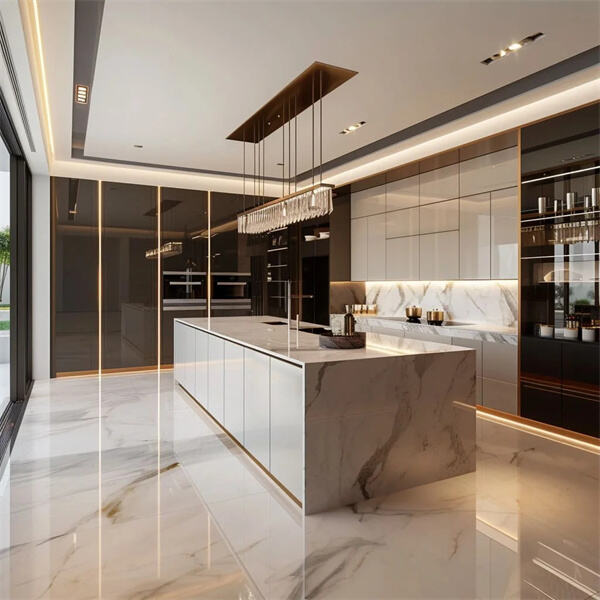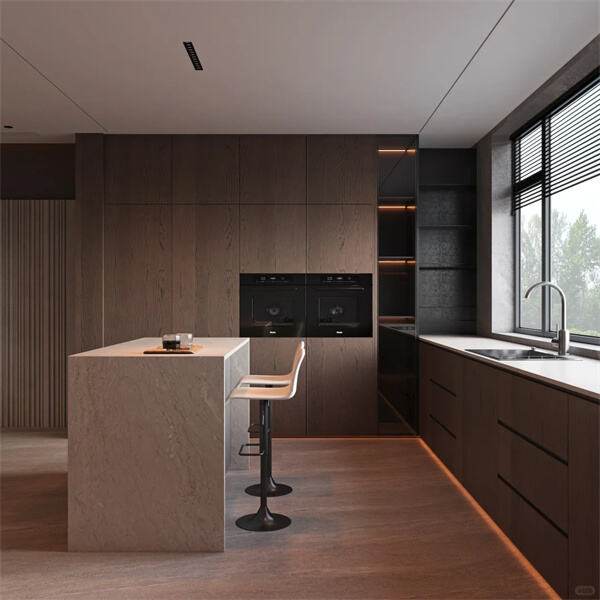Bold and Dark Kitchen Cabinet Color Trends in 2025
Trending Colors: Charcoal, Forest Green, and Midnight Blue Dominance
For 2025, neutrals make way for deep, moody kitchen cabinet colors as the be-all and end-all of best 2025 kitchen design palettes. Charcoal, woodland green and midnight blue emerge as frontrunners for those creating elegant kitchens. In fact, they’re what two-thirds (68% to be exact) of designers surveyed are fielding from homeowners in the know, who, by the way, want them to find something other than traditional white; design pros reported a 65% uptick in clients asking for offbeat colorways.
Lacquered vs Matte Finishes: 2025's Textural Preferences
Texture plays a pivotal role in dark cabinet aesthetics, with matte finishes gaining preference for their contemporary elegance. Lacquered surfaces remain popular for high-gloss luxury. Industry analysts highlight that matte finishes reduce visible fingerprints by 40% compared to gloss options, making them a practical choice alongside their visual appeal.
Psychology Behind Bold Tones in Modern Kitchens
Dark kitchen cabinets create psychological impacts that explain their surging popularity. Deep hues generate feelings of security and intimacy in communal spaces like kitchens, transforming them into comforting sanctuaries. Chromatic psychologists attribute this to how dark shades absorb rather than reflect stimuli, offering emotional respite during fast-paced daily routines.
Micro Shaker Profiles with Layered Dark Base Cabinets
Contemporary cabinet designs integrate dark palettes through tailored techniques like the micro shaker profile, which prevents overwhelming smaller spaces. Designers often apply dark shades to base cabinets while keeping uppers lighter, a strategy that 7 out of 10 kitchens now implement for balanced visual weight distribution.
Two-Tone Kitchen Cabinet Combinations for Modern Spaces
Upper/Lower Contrast Strategies Using Wood and Painted MDF
The most popular two-tone strategy pairs richly pigmented lower cabinets with light-toned uppers, using durable materials like wood veneers and painted MDF. This approach enhances spatial perception, particularly in smaller kitchens. Popular combinations include navy lowers with cream uppers and forest green bases paired with natural oak overhead cabinetry.
Balancing Bold Island Statements with Neutral Perimeter Cabinets
Contemporary kitchens embrace bold island statements framed by neutral perimeter cabinets, allowing vibrant hues to shine without overwhelming the space. Design experts suggest pairing deep emerald or burgundy islands with soft white or warm gray perimeters, creating dynamic focal points in open-concept layouts.
2025's Most Unexpected Material Pairings
Designers are pushing boundaries with unexpected material hybrids in 2025’s two-tone kitchens. Textured resin panels paired with reclaimed wood offer contrasting durability and organic appeal, while recycled glass composites with matte-finished MDF create visual tension between industrial and artisanal elements.
Natural Finishes and Textures: The Shift to Organic Kitchen Cabinets
Reclaimed Wood Adoption Rates (65% Industry Growth Reported)
The kitchen cabinet industry reports a 65% surge in reclaimed wood adoption since 2023, driven by sustainability demands and nostalgia for artisanal craftsmanship. A 2025 National Kitchen & Bath Association (NKBA) study found 72% of remodelers now source wood from certified deconstruction projects, reflecting a broader shift toward circular design principles.

Water-Based Finishes and Rough-Sawn Surface Demand
Low-VOC (volatile organic compounds) water-based finishes dominate 85% of new cabinet projects, according to EcoDesign Magazine’s 2024 analysis. Rough-sawn textures, with their intentionally uneven grain patterns, grew 40% in popularity year-over-year, offering tactile appeal and masking daily wear.
Nordic Minimalism Meets Live-Edge Detailing
Designers blend Scandinavian simplicity with organic imperfections, pairing streamlined shaker cabinets in rift-cut oak with live-edge walnut breakfast bars. This trend emphasizes “quiet contrast”—smooth, muted bases against raw natural edges.
Case Study: Urban Farmhouse Aesthetic Breakthroughs
A recent Chicago renovation paired reclaimed pine upper cabinets with rough-textured MDF lowers stained in driftwood grays, achieving farmhouse warmth without rustic clichés. The design increased storage functionality by 30% and improved emotional connection to the space for 89% of users.
Colorful Kitchen Cabinets and Statement Island Palettes
Jewel-Toned Islands as Focal Points: 2025 Data Insights
Jewel-toned islands are dominating kitchen designs as strategic focal points in 2025. Emerald greens, sapphire blues, and amethyst purples transform islands into functional art installations. Industry analytics reveal a 70% increase in colored island installations since pre-2020 norms, boosting perceived room value by up to 15% in appraisal scenarios.
Monochromatic vs Accent Wall Implementation Strategies
Monochromatic schemes layer various tones of one color family for seamless harmony, while accent wall strategies inject bold pigments on focal zones like prep walls or hood surrounds. Implementation data indicates homeowners prefer accent walls in secondary prep zones to avoid visual fatigue, reserving statement islands for primary impact.
Controversy Analysis: Are Rainbow Cabinets Here to Stay?
The rainbow cabinet movement faces polarized debate among design authorities. While 35% of designers deem multi-hued schemes transitional, innovators argue they represent personality-forward evolution. Evidence shows committed adoption from Gen Z homeowners (+27% year-over-year), suggesting rainbow elements may persist in personalized kitchens.
Mid-Century Modern Revival in Kitchen Cabinet Design
Slim Profiles and Angular Hardware Resurgence
2025’s mid-century modern revival emphasizes streamlined silhouettes, with cabinet depths shrinking 15-20% compared to bulkier 2010s designs. Slim shaker profiles dominate installations, and angular brass pulls and geometric knobs replace ornate fixtures. Industry surveys show a 220% increase in trapezoid-shaped hardware requests since 2022.
Retro Color Palettes Reimagined with Modern Materials
Manufacturers reinterpret 1950s hues like mustard yellow and teal using scratch-resistant acrylic laminates and UV-stable wood stains. A 2024 NKBA report reveals 38% of homeowners now pair warm walnut veneers with atomic-age accent colors on islands or floating shelves.
Blending Functionality with Atomic-Era Aesthetics
Designers merge period-correct elements like tapered legs and boomerang patterns with soft-close drawers and integrated charging stations. The trend’s success hinges on balancing nostalgia with ergonomics: 72% of renovated kitchens now feature curved breakfast bars mimicking 1950s diners, yet 89% include pull-out trash systems discreetly tucked behind cabinet panels.
Sustainable Kitchen Cabinet Materials: Eco-Conscious Construction
Bamboo and Recycled Composite Adoption Rates
Bamboo adoption is accelerating due to its rapid regrowth cycle and natural durability. Recycled composites—made from post-consumer plastics and reclaimed wood fibers—offer comparable performance to virgin materials while diverting waste from landfills. Industry sources confirm these materials now comprise over 30% of eco-focused kitchen renovations.
Low-VOC Finish Market Projections (40% CAGR Through 2025)
Low-VOC (volatile organic compounds) finishes are transforming cabinetry with safer chemical formulations. Independent studies verify their effectiveness in reducing indoor air pollutants by up to 90%. This segment is projected to grow at a 40% compound annual growth rate through 2025, driven by heightened health awareness and stricter indoor air quality regulations.
Circular Design Principles in Custom Cabinetry
Forward-thinking manufacturers now implement circular design principles to combat furniture waste. This approach prioritizes modular construction, standardized components, repurposable materials, and chemical-free joinery. Lifecycle assessments prove these methods reduce cabinet-related landfill waste by 65%, shifting kitchen design from disposable to regenerative.
FAQ
What are the trending kitchen cabinet colors for 2025?
In 2025, trending colors include charcoal, forest green, and midnight blue, which are favored for their elegant and moody aesthetics.
Why are matte finishes preferred over lacquered finishes in kitchen cabinets?
Matte finishes are preferred because they offer contemporary elegance and reduce visible fingerprints by 40% compared to lacquered surfaces.
What is the significance of two-tone kitchen cabinet designs?
Two-tone designs create contrast and enhance spatial perception, especially in smaller kitchens, by pairing bold lower cabinets with lighter uppers.
How is the use of reclaimed wood influencing kitchen cabinet trends?
The use of reclaimed wood is on the rise due to sustainability demands, with industry growth of 65% driven by a preference for circular design principles.
Table of Contents
- Bold and Dark Kitchen Cabinet Color Trends in 2025
- Two-Tone Kitchen Cabinet Combinations for Modern Spaces
- Natural Finishes and Textures: The Shift to Organic Kitchen Cabinets
- Colorful Kitchen Cabinets and Statement Island Palettes
- Mid-Century Modern Revival in Kitchen Cabinet Design
- Sustainable Kitchen Cabinet Materials: Eco-Conscious Construction
- FAQ

